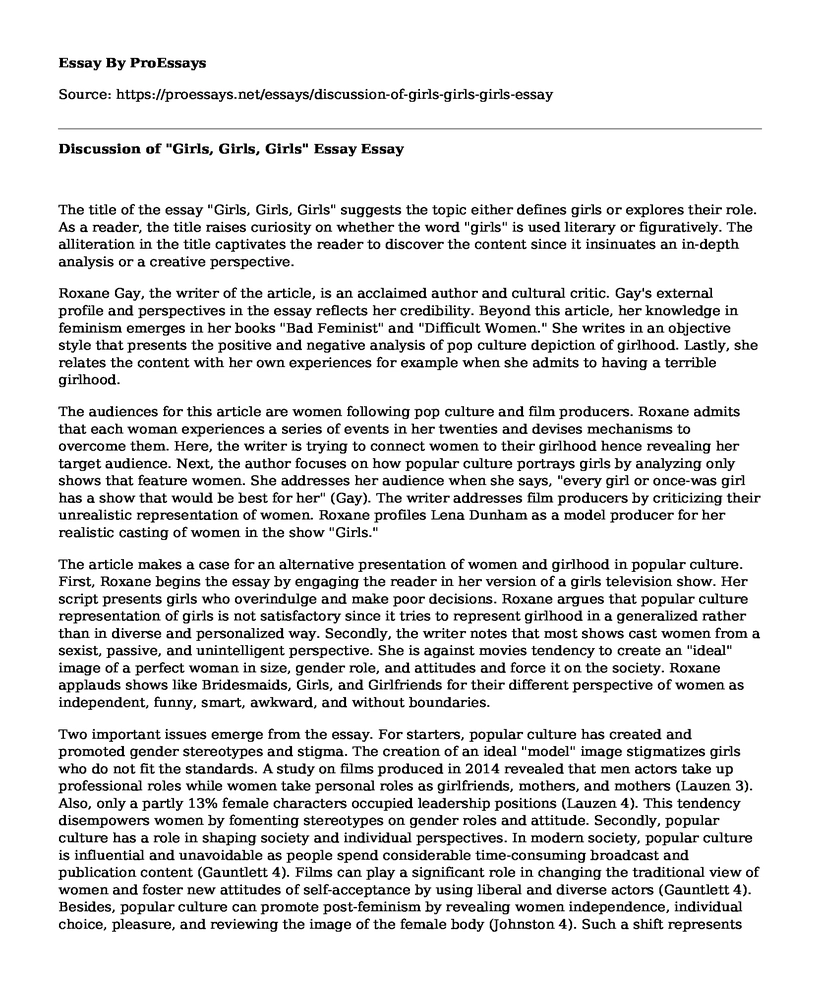The title of the essay "Girls, Girls, Girls" suggests the topic either defines girls or explores their role. As a reader, the title raises curiosity on whether the word "girls" is used literary or figuratively. The alliteration in the title captivates the reader to discover the content since it insinuates an in-depth analysis or a creative perspective.
Roxane Gay, the writer of the article, is an acclaimed author and cultural critic. Gay's external profile and perspectives in the essay reflects her credibility. Beyond this article, her knowledge in feminism emerges in her books "Bad Feminist" and "Difficult Women." She writes in an objective style that presents the positive and negative analysis of pop culture depiction of girlhood. Lastly, she relates the content with her own experiences for example when she admits to having a terrible girlhood.
The audiences for this article are women following pop culture and film producers. Roxane admits that each woman experiences a series of events in her twenties and devises mechanisms to overcome them. Here, the writer is trying to connect women to their girlhood hence revealing her target audience. Next, the author focuses on how popular culture portrays girls by analyzing only shows that feature women. She addresses her audience when she says, "every girl or once-was girl has a show that would be best for her" (Gay). The writer addresses film producers by criticizing their unrealistic representation of women. Roxane profiles Lena Dunham as a model producer for her realistic casting of women in the show "Girls."
The article makes a case for an alternative presentation of women and girlhood in popular culture. First, Roxane begins the essay by engaging the reader in her version of a girls television show. Her script presents girls who overindulge and make poor decisions. Roxane argues that popular culture representation of girls is not satisfactory since it tries to represent girlhood in a generalized rather than in diverse and personalized way. Secondly, the writer notes that most shows cast women from a sexist, passive, and unintelligent perspective. She is against movies tendency to create an "ideal" image of a perfect woman in size, gender role, and attitudes and force it on the society. Roxane applauds shows like Bridesmaids, Girls, and Girlfriends for their different perspective of women as independent, funny, smart, awkward, and without boundaries.
Two important issues emerge from the essay. For starters, popular culture has created and promoted gender stereotypes and stigma. The creation of an ideal "model" image stigmatizes girls who do not fit the standards. A study on films produced in 2014 revealed that men actors take up professional roles while women take personal roles as girlfriends, mothers, and mothers (Lauzen 3). Also, only a partly 13% female characters occupied leadership positions (Lauzen 4). This tendency disempowers women by fomenting stereotypes on gender roles and attitude. Secondly, popular culture has a role in shaping society and individual perspectives. In modern society, popular culture is influential and unavoidable as people spend considerable time-consuming broadcast and publication content (Gauntlett 4). Films can play a significant role in changing the traditional view of women and foster new attitudes of self-acceptance by using liberal and diverse actors (Gauntlett 4). Besides, popular culture can promote post-feminism by revealing women independence, individual choice, pleasure, and reviewing the image of the female body (Johnston 4). Such a shift represents Roxane critic against a uniform conception of woman.
Roxane article provides a balanced analysis of how popular culture presents girlhood. Most television shows do not capture the diversity and individuality of girl's experiences. Some films offer a biased, sexist or unrealistic view of women. There is a need for shows like Girls and Girlfriend that capture women diversity, independence, wits, and indulgence. Increasingly, women are looking for programs and books that present a new and relatable perspective.
Works Cited
Gauntlett, David. Media, gender, and identity: An introduction. London: Routledge, 2008.
Gay, Roxane. Girls, girls, girls. The Rumpus, 2012, http://therumpus.net/2012/05/girls-girls-girls/. Accessed 21 March 2018.
Johnston, Jane. "Girls on screen: How film and television depict women in public relations." Prism, vol. 7, no. 4, 2010, pp. 1-4.
Meltzer Marisa. Roxane Gay's new memoir hunger as the most feminist act ever. Elle, June 2017, https://www.elle.com/culture/a45920/roxane-gay-profile-hunger-memoir/. Accessed 21 March 2018.
Lauzen, Martha M. "It's a man's (celluloid) world: On-screen representation of female characters in the top 100 films of 2014." Center for the Study of Women in Television and Film at San Diego State University, 2015.
Cite this page
Discussion of "Girls, Girls, Girls" Essay. (2022, Apr 04). Retrieved from https://proessays.net/essays/discussion-of-girls-girls-girls-essay
If you are the original author of this essay and no longer wish to have it published on the ProEssays website, please click below to request its removal:
- Essay Example: Refugees Freedom of Movement as a Human Right
- Paper Example on Racism in the Classroom
- Essay Sample on Rape Kit Backlog
- Essay Sample on Los Angeles Homeless Crisis
- Essay Example on Organ Trafficking in Egypt: They Locked Me In and Took My Kidney
- Essay on School Improvement: Drafting a Strategy for Better Outcomes
- Essay Example on African American Inequality in Criminal Justice System







